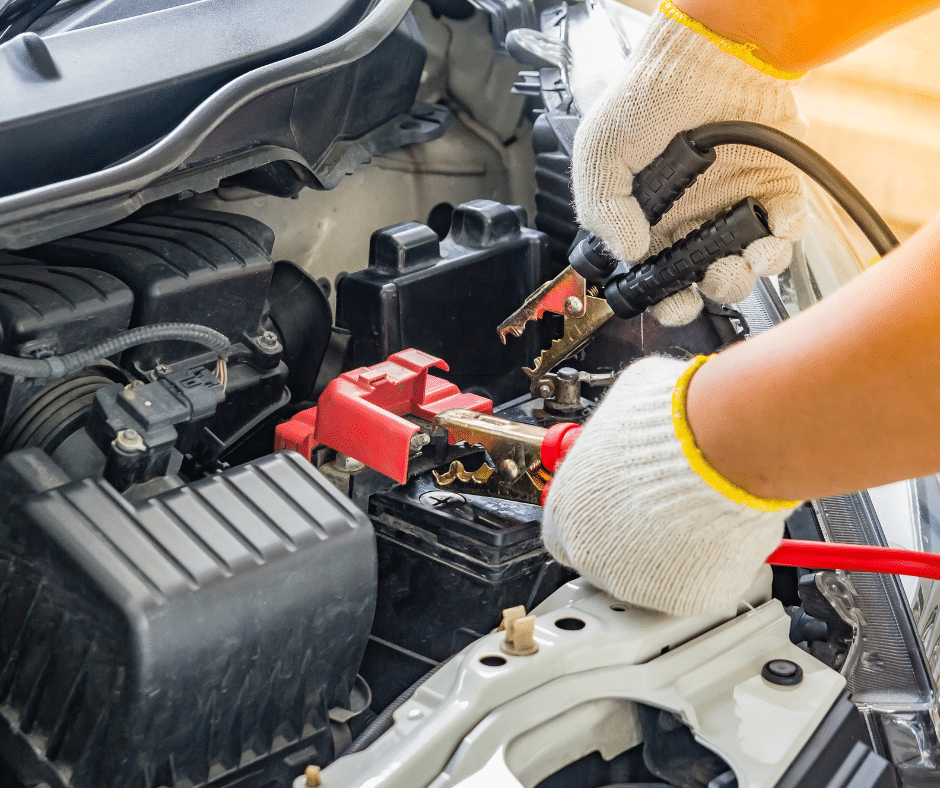Imagine it’s a brisk morning, and your car won’t start because of a dead battery. This situation is more common than you might think, and it can throw a wrench into your plans. Fortunately, with the right knowledge, you can get back on the road quickly. In this guide, Buckhead Roadside Assistance & Mobile Tire Repair will walk you through how to safely jumpstart your car. Mastering this skill could save you from delays and unnecessary stress.
What You Need to Know Before Jumpstarting
Before attempting to jumpstart your vehicle, taking some safety precautions is crucial. Ensure that both vehicles are off and set in park or neutral. Check that the battery you’re using as a source isn’t damaged or leaking. Familiarize yourself with the battery terminals, identifying the positive and negative. This knowledge will help prevent accidents and ensure a smooth process.
Essential Tools for Jumpstarting Your Car
To successfully jumpstart your car, you need reliable tools. A set of heavy-duty jumper cables is a must, as they are the conduit for battery power. Inspect your cables for any wear or tear before use to ensure they can handle the task. Gloves and goggles are also essential, protecting you from sparks or battery acid. Keep these tools in your vehicle at all times for emergencies.
Step-by-Step Guide to Jumpstarting
Jumpstarting your car is a straightforward process if you follow these steps correctly. Ensuring safety and efficiency is key to successfully reviving a dead battery.
- Position the Vehicles: Park the donor vehicle close enough so the jumper cables can comfortably reach both batteries.
- Connect Positive to Dead Battery: Attach the red clamp to the positive terminal of the dead battery first.
- Connect Positive to Donor Battery: Secure the other red clamp to the positive terminal of the donor battery.
- Ground the Dead Vehicle: Clamp the black cable to an unpainted metal surface on the engine block of the dead vehicle.
- Connect Negative to Donor Battery: Finally, attach the black clamp to the negative terminal of the donor battery.
- Start the Donor Vehicle: Turn on the donor vehicle and let it idle for a few minutes to charge the dead battery.
- Try to Start Your Vehicle: Attempt to start your vehicle; if it starts, let it run to help recharge the battery.
After following these steps, your vehicle should start if the battery is the only issue. Remember, if your vehicle does not start after the first attempt, check your connections and ensure they are secure and correctly placed before trying again.
Troubleshooting Common Issues
If the car doesn’t start after following the jumpstarting procedure, double-check your connections. Ensure the cable clamps are making good contact with the terminals and the engine block. If there are no sparks and your car still won’t start, your battery might be beyond jumpstarting. At this point, refrain from further attempts and call for professional help. Persistent issues could indicate a deeper mechanical problem.
Preventative Measures to Avoid a Dead Battery
The best way to deal with a dead battery is to prevent it from happening. Regularly check your battery’s charge level, especially in extreme temperatures, which can drain battery life. Keep the battery terminals clean from corrosion by wiping them periodically with a solution of baking soda and water. Avoid using electronics like the radio or lights when the engine isn’t running. Finally, consider a battery replacement every 4-5 years.
When to Call a Professional
Not all battery problems can be solved with a jumpstart. If you’ve tried jumpstarting your vehicle without success, it may be time to consult a professional. This is particularly important if you notice unusual noises or smoke or if the battery is swollen. Professionals like Buckhead Roadside Assistance & Mobile Tire Repair can safely diagnose and resolve complex issues. It’s better to rely on experts than to risk further damage to your vehicle.
Benefits of Regular Vehicle Maintenance
Regular maintenance extends beyond oil changes and tire rotations; it includes taking care of your car’s battery. By scheduling regular inspections, you can catch issues before they leave you stranded. Consistent care ensures your vehicle remains efficient, safe, and ready to perform when needed. Trusting professionals like those at Buckhead Roadside Assistance & Mobile Tire Repair for regular checks can save you time and money in the long run.
Contact Us for Roadside Assistance
Dealing with car troubles can be challenging, but you don’t have to face them alone. Buckhead Roadside Assistance & Mobile Tire Repair is here to provide you with reliable roadside assistance and expert vehicle care. If you’re ever in a bind and need immediate help, don’t hesitate to search for “jump-start my car near me,” and our team at Buckhead Roadside Assistance & Mobile Tire Repair will be ready to assist you promptly.
